Paul Devine
-
- Advancing Climate Change Research and Hydrocarbon Leak Detection Marine Technology, Mar 2013 #18
By Combining Dissolved Carbon Dioxide and Methane Measurements with ADCP Data.
With the emergence of large-scale, comprehensive environmental monitoring projects, there is an increased need to combine state-of-the art technologies to address complicated problems such as ocean acidification and hydrocarbon leak detection.
Carbon is a building block of life on earth and is a key element of many ocean chemical processes. The ability to measure dissolved carbon dioxide (CO2) and methane (CH4) in the ocean is beneficial for a wide variety of oceanographic and limnological applications. Recently, there has been an increased demand for two specific carbon sensing applications: one for researching the effects of climate change on the ocean environment and another for operational use in the oil and gas industry. Sensing of dissolved CO2 allows for better quantification of the global carbon cycle and understanding how increased levels of dissolved carbon dioxide in the atmosphere affect the oceanic carbon budget, the resulting acidification of the oceans, and the corresponding influence on marine organisms and habitat. Sensing dissolved CH4 in oceans or lakes allows one to find regions of elevated concentrations fed by naturally occurring hydrocarbon seeps, melting methane hydrate bearing permafrost, or potential leaks from an oil and gas well, production facility, or pipeline.
Teledyne Marine has recently licensed technology developed by CONTROS GmbH to produce the HydroCO2 and HydroCH4 instruments and allow its customers to better address their bio-geochemical as well as oil and gas-related applications.
Combining carbon dioxide and/or methane concentration data with the physical oceanographic parameters measured with Teledyne RD Instruments’ Acoustic Doppler Current Profilers (ADCPs) and Conductivity Temperature and Depth (CTD) sensors will allow improved understanding of biogeochemical processes as a function of ocean temperature, salinity, mixing, and advective transport. Integration of the ADCP current profiles and volumetric transport information with the dissolved gas readings from the HydroCO2 and HydroCH4 systems will also improve the utility of hydrocarbon leak detection programs by allowing users to backtrack the “up current” to identify the source of the seep or leak.
Facilitating and expanding data collection will be accomplished by integrating the HydroCO2 and HydroCH4 in-situ sensor technologies with other Teledyne Instruments, Inc. product offerings. Examples are the Teledyne Benthos, Teledyne Webb Research, and Teledyne Gavia tethered, towed, and autonomous vehicles. The HydroCH4 sensor may be combined with the Teledyne TSS Pipe Detection system via the Mobile Early Leak Detection System (MELDS) for detecting the presence of hydrocarbons in water.
The HydroCO2 and HydroCH4 products utilize a flat hydrophobic membrane that forms a semi permeable phase boundary between full ocean depth pressures and the interior of the instrument. Dissolved gasses in the water pass into an equilibrated internal headspace in the form of a gas stream. Concentration of CO2 or CH4 in the gas stream is quantified using an industry standard non-dispersive infrared detector (NDIR-detector) and the principle of absorption spectrometry (1). To overcome the temperature dependency of the NDIR sensors, the detector is temperature stabilized and the gas is lead through a heater before entering the NDIR unit both during initial instrument calibration as well as during operation in the field. To compensate for the long term drift of the sensor, a “zero point” reference is routinely taken by the NDIR-detector within the instrument after the air within the gas stream has been chemically freed from CO2 or CH4. This zero reference data can be used to track the temporal signal drift of the NDIR-detector and allows for the derivation of the sensor’s actual response time (2).
The HydroCO2 and HydroCH4 physical packaging allows for a wider range of deployment possibilities than previously available with existing dissolved CO2 and CH4 measurement systems. When configured as a flow through system inside of a vessel or within a laboratory, these instruments have a significantly reduced maintenance effort and smaller size than prevailing underway systems that use large equilibration chambers and bottles of reference gasses. Use of the HydroCO2 and HydroCH4 systems enable deployment from smaller vessels, adding a valuable measurement parameter while reducing the energy and space requirements (e.g., less room occupied in a vessel’s wet lab). When configured as a self-contained submersible system, the systems will operate from water surface to 6000m of depth. The 9 cm diameter pressure housing on the system allows for easy deployment on buoys, moorings, AUV’s, gliders and Argo floats (2 and 3). Example of a bottom lander deployment combining an ADCP and the HydroCH4 sensor is shown here.
Instruments for Loan:
Apply Before April 15!
Teledyne RD Instruments is confident that these carbon sensors will aid in both scientific research and environmental monitoring. Through a newly established product grant program, Teledyne RD Instruments will offer the loan of up to 3 instruments – one each of either a HydroCO2, a HydroCH4 senor, a WH/OS ADCP, or Citadel CTD system – for new and interesting applications utilizing these combined technologies.
Users are encouraged to submit detailed proposals on how they would utilize these products to improve their scientific research or environmental monitoring.
Full details and an online submission form can be accessed at
www.rdinstruments.com. Proposals are due on or before April 15, 2013.References
(1) Fietzek, P. & Körtzinger, A. (2010) Optimization of a membrane based NDIR-Sensor for Dissolved Carbon Dioxide. In Proceedings of “OceanObs’09: Sustained Ocean Observations and Information for Society” Conference (Annex), Venice, Italy, 21-25 September 2009, Hall, J., Harrison D.E. & Stammer, D., Eds., ESA Publication WPP-306.
(2) Fiedler, B., Fietzek, P., Vieira, N., Silva, P., Bittig, H.C. and Körtzinger, A. (2013): In situ CO2 and O2 measurements on a profiling float, Journal of Atmospheric and Oceanic Technology, 30 . pp. 112-126.
(3) Fietzek, P., Kramer, S. & Esser, D. (2011) Deployments of the HydroC (CO2/CH4) on stationary and mobile platforms – Merging trends in the field of platform and sensor development. In Proceedings of Oceans 2011 conference (USA, September 2011).
(4) Deployment photo courtesy of Dr. Peter Linke, GEOMAR http://www.geomar.de/index.php?id=plinke.
(As published in the March 2013 edition of Marine Technologies - www.seadiscovery.com)
-
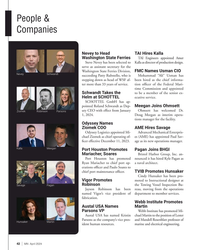 )
April 2024 - Marine News page: 42
)
April 2024 - Marine News page: 42Names Ziomek COO AME Hires Savage Odyssey Logistics appointed Mi- Advanced Mechanical Enterpris- chael Ziomek as chief operating of- es (AME) has appointed Paul Sav- ? cer effective December 11, 2023. age as its new operations manager. Kalla Meegan Port Houston Promotes Pagan Joins BHGI Mariacher, Soares Bristol
-
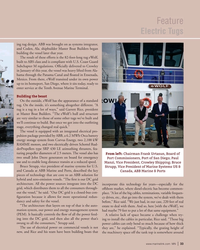 )
April 2024 - Marine News page: 33
)
April 2024 - Marine News page: 33vessel also has From left: Chairman Frank Urtasun, Board of two small John Deere generators on board for emergency Port Commissioners, Port of San Diego; Paul use and to enable long distance transits at a reduced speed. Manzi, Vice President, Crowley Shipping; Bruce Bruce Strupp, vice president of marine
-
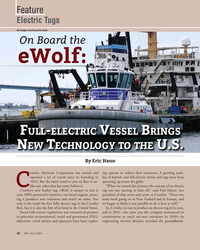 )
April 2024 - Marine News page: 32
)
April 2024 - Marine News page: 32. “When we started this journey, the concept of an electric Crowley’s new harbor tug, eWolf, is unique in that it tug was just starting to kick off,” said Paul Manzi, vice runs 100% powered by batteries, not diesel engines, mean- president of ship assist and escort at Crowley. “There was ing it produces zero
-
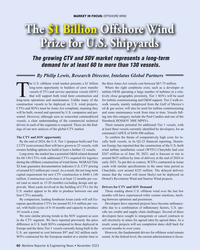 )
November 2023 - Maritime Reporter and Engineering News page: 60
)
November 2023 - Maritime Reporter and Engineering News page: 60per- and some maintenance work from time to time. Vessels fall- sonnel. However, although seen as somewhat commoditized ing into this category include the Paul Candies and one of the vessels, a clear understanding of the commercial technical Hornbeck HOSSOV 300E MPSVs. drivers in each of the segments is required
-
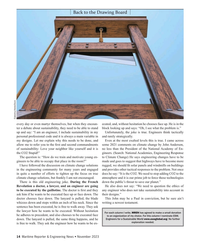 )
November 2023 - Maritime Reporter and Engineering News page: 14
)
November 2023 - Maritime Reporter and Engineering News page: 14him if he wants to be executed face up or face down. The their designs.” doctor chooses face down. The lanyard is pulled, the blade This John may be a Paul in conviction, but he sure ain’t whizzes down and stops within an inch of his neck. Since the writing a newest testament. sentence has been executed
-
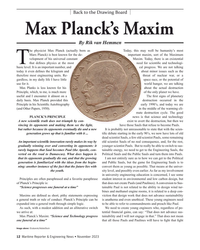 )
November 2023 - Maritime Reporter and Engineering News page: 12
)
November 2023 - Maritime Reporter and Engineering News page: 12triumph by con- exist to avert the destruction, but then we vincing its opponents and making them see the light, have those Sauls that refuse to become Pauls. but rather because its opponents eventually die and a new It is probably not unreasonable to state that with the scien- generation grows up that
-
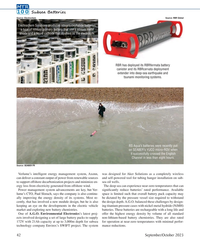 )
September 2023 - Marine Technology Reporter page: 42
)
September 2023 - Marine Technology Reporter page: 42temperatures that can Power management system advancements are key, but Ver- signi? cantly reduce batteries’ rated performance. Available lume’s CTO, Paul Slorach, says the company is also continu- space is limited such that overall battery pack capacity may ally improving the energy density of its systems
-
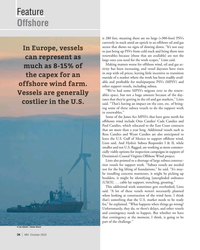 )
October 2023 - Marine News page: 34
)
October 2023 - Marine News page: 34vessels to do the support work in renewables.” Some of the Jones Act MPSVs that have gone north for offshores wind include Otto Candies’ Cade Candies and Paul Candies, which relocated to the East Coast contracts that are more than a year long. Additional vessels such as Ross Candies and Wyatt Candies are
-
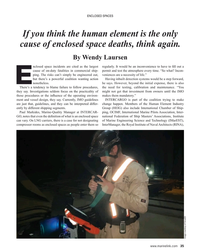 )
September 2023 - Maritime Reporter and Engineering News page: 35
)
September 2023 - Maritime Reporter and Engineering News page: 35differ- change happen. Members of the Human Element Industry ently by different shipping segments. Group (HEIG) also include International Chamber of Ship- Paul Markides, Marine-Quality Manager at INTERCAR- ping, OCIMF, International Marine Pilots Association, Inter- GO, notes that even the de? nition of what
-
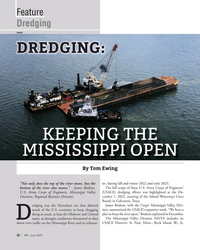 )
June 2023 - Marine News page: 32
)
June 2023 - Marine News page: 32threatened to shut The Mississippi Valley Division (MVD) includes six down river traf? c on the Mississippi River and its tributar- USACE Districts: St. Paul, Minn.; Rock Island, Ill.; St. 32 | MN June 2023 MN June23 Layout 32-45.indd 32 5/19/2023 3:11:36 P
-
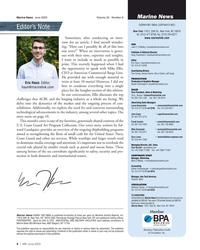 )
June 2023 - Marine News page: 4
)
June 2023 - Marine News page: 4attention, it’s important not to overlook the Managing Director, Intl. Sales crucial role played by smaller vessels such as patrol and rescue boats. These Paul Barrett • [email protected] Tel: +44 1268 711560 Fax: +44 1268 711567 unsung heroes of the sea contribute signi? cantly to safety, security and pro- CORPOR
-
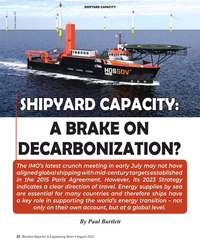 )
August 2023 - Maritime Reporter and Engineering News page: 22
)
August 2023 - Maritime Reporter and Engineering News page: 22many countries and therefore ships have a key role in supporting the world’s energy transition – not only on their own account, but at a global level. By Paul Bartlett 22 Maritime Reporter & Engineering News • August 2023 MR #8 (18-33).indd 22 8/3/2023 10:54:05 A
-
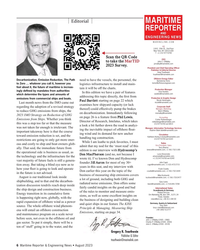 )
August 2023 - Maritime Reporter and Engineering News page: 6
)
August 2023 - Maritime Reporter and Engineering News page: 6and amounts of addressing this topic directly, the ? rst from Production & Graphic Design emissions from commercial ships and boats. Nicole Ventimiglia Paul Bartlett starting on page 22 which [email protected] Last month news from the IMO came out examines how shipyard capacity (or lack Corporate
-
 )
August 2023 - Maritime Reporter and Engineering News page: 4
)
August 2023 - Maritime Reporter and Engineering News page: 4$140.00; two years $180.00 (18 printed issues) including postage and handling. Bartlett experience as a journalist. She engineering applications. Paul Bartlett is a maritime jour- has a Master of Science research nalist and consultant with experi- degree in marine ecology as well Stagner CONTACT
-
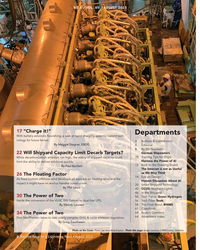 )
August 2023 - Maritime Reporter and Engineering News page: 2
)
August 2023 - Maritime Reporter and Engineering News page: 2high, the reality of shipyard capacity could Harness the Power of AI limit the ability to deliver solutions quickly. 12 Back to the Drawing Board: By Paul Bartlett The Internet is not as Useful as We May Think 26 The Floating Factor 14 Eye on Design: As fxed bottom offshore wind develops, all eyes
-
 )
August 2023 - Marine News page: 4
)
August 2023 - Marine News page: 4projects Tel: 516-441-7258 and the new innovations helping shipyards to do what they do best: get Managing Director, Intl. Sales the job done. Paul Barrett • [email protected] Tel: +44 1268 711560 Fax: +44 1268 711567 CORPORATE STAFF Manager, Marketing Mark O’Malley • momalley@marinelink
-
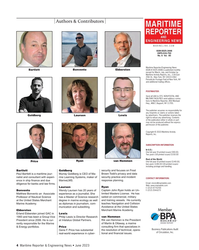 )
June 2023 - Maritime Reporter and Engineering News page: 4
)
June 2023 - Maritime Reporter and Engineering News page: 4year (9 printed issues) $140.00; two years $180.00 (18 printed issues) including postage and handling. Bartlett Goldberg security and focuses on Frost Paul Bartlett is a maritime jour- Murray Goldberg is CEO of Ma- Brown Todd’s privacy and data nalist and consultant with experi- rine Learning Systems,
-
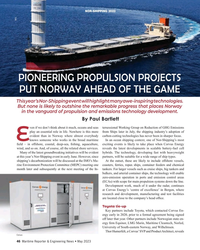 )
May 2023 - Maritime Reporter and Engineering News page: 46
)
May 2023 - Maritime Reporter and Engineering News page: 46. But none is likely to outshine the remarkable progress that places Norway in the vanguard of propulsion and emissions technology development. By Paul Bartlett ven if we don’t think about it much, oceans and seas tersessional Working Group on Reduction of GHG Emissions play an essential role in life
-
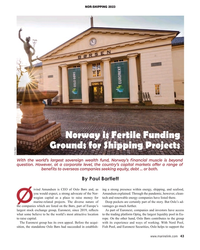 )
May 2023 - Maritime Reporter and Engineering News page: 43
)
May 2023 - Maritime Reporter and Engineering News page: 43. However, at a corporate level, the country’s capital markets offer a range of bene? ts to overseas companies seeking equity, debt … or both. By Paul Bartlett ivind Amundsen is CEO of Oslo Børs and, as ing a strong presence within energy, shipping, and seafood, you would expect, a strong advocate
-
 )
May 2023 - Maritime Reporter and Engineering News page: 26
)
May 2023 - Maritime Reporter and Engineering News page: 26growth for more than a decade this year and next. Protesters cause disruption but, for the moment, hydrocarbon energy underpins life as we know it. By Paul Bartlett 26 Maritime Reporter & Engineering News • May 2023 MR #5 (18-33).indd 26 5/1/2023 10:03:57 A
-
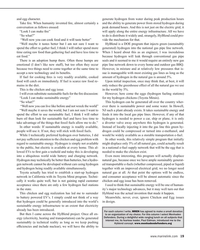 )
May 2023 - Maritime Reporter and Engineering News page: 19
)
May 2023 - Maritime Reporter and Engineering News page: 19a delightful wide ranging lunch on all subjects that ergy (electricity, heating and transportation) can be generated interest me, its fearless leader, Paul Eidman, introduced me to the sustainably (a technical reality as long as we keep pushing Hyblend concept. www.menhadendefenders.org ef? ciencies
-
 )
May 2023 - Maritime Reporter and Engineering News page: 6
)
May 2023 - Maritime Reporter and Engineering News page: 6a dedicated likely fraught with equal doses of failure International Sales Scandinavia & Germany vessel for Tohoku Electric Power Co. and success. As Paul Barlett opines in the Roland Persson Orn Marketing AB, Box 184 , S-271 24 The introduction of the Wind Challenger opening of his energy transition
-
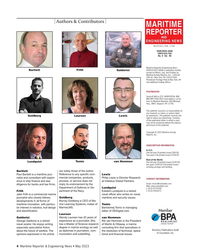 )
May 2023 - Maritime Reporter and Engineering News page: 4
)
May 2023 - Maritime Reporter and Engineering News page: 4full year (9 printed issues) $140.00; two years $180.00 (18 printed issues) including postage and handling. Bartlett are solely those of the author. Paul Bartlett is a maritime jour- Reference to any speci? c com- Lewis nalist and consultant with experi- mercial companies, products, Philip Lewis is
-
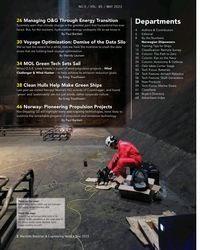 )
May 2023 - Maritime Reporter and Engineering News page: 2
)
May 2023 - Maritime Reporter and Engineering News page: 2is the greatest peril that humankind has ever faced. But, for the moment, hydrocarbon energy underpins life as we know it. 4 Authors & Contributors By Paul Bartlett 6 Editorial 8 By the Numbers: Norwegian Shipowners 30 Voyage Optimization: Demise of the Data Silo 10 Training Tips for Ships We’ve had
